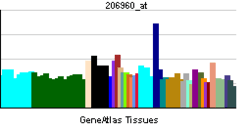LPAR4
| LPAR4 | |||||||||||||||||
|---|---|---|---|---|---|---|---|---|---|---|---|---|---|---|---|---|---|
| Identifiers | |||||||||||||||||
| Aliases | LPAR4, GPR23, LPA4, P2RY9, P2Y5-LIKE, P2Y9, lysophosphatidic acid receptor 4 | ||||||||||||||||
| External IDs | MGI: 1925384 HomoloGene: 3871 GeneCards: LPAR4 | ||||||||||||||||
| Targeted by Drug | |||||||||||||||||
| lysophosphatidic acid[1] | |||||||||||||||||
| |||||||||||||||||
| RNA expression pattern | |||||||||||||||||
 | |||||||||||||||||
| More reference expression data | |||||||||||||||||
| Orthologs | |||||||||||||||||
| Species | Human | Mouse | |||||||||||||||
| Entrez | |||||||||||||||||
| Ensembl | |||||||||||||||||
| UniProt | |||||||||||||||||
| RefSeq (mRNA) | |||||||||||||||||
| RefSeq (protein) | |||||||||||||||||
| Location (UCSC) | Chr X: 78.75 – 78.76 Mb | Chr X: 106.92 – 106.93 Mb | |||||||||||||||
| PubMed search | [2] | [3] | |||||||||||||||
| Wikidata | |||||||||||||||||
| View/Edit Human | View/Edit Mouse |
Lysophosphatidic acid receptor 4 also known as LPA4 is a protein that in humans is encoded by the LPAR4 gene.[4][5][6] LPA4 is a G protein-coupled receptor that binds the lipid signaling molecule lysophosphatidic acid (LPA).[7]
See also
References
- ↑ "Drugs that physically interact with Lysophosphatidic acid receptor 4 view/edit references on wikidata".
- ↑ "Human PubMed Reference:".
- ↑ "Mouse PubMed Reference:".
- ↑ "Entrez Gene: GPR23 G protein-coupled receptor 23".
- ↑ Janssens R, Boeynaems JM, Godart M, Communi D (July 1997). "Cloning of a human heptahelical receptor closely related to the P2Y5 receptor". Biochem. Biophys. Res. Commun. 236 (1): 106–12. doi:10.1006/bbrc.1997.6895. PMID 9223435.
- ↑ O'Dowd BF, Nguyen T, Jung BP, Marchese A, Cheng R, Heng HH, Kolakowski LF, Lynch KR, George SR (March 1997). "Cloning and chromosomal mapping of four putative novel human G-protein-coupled receptor genes". Gene. 187 (1): 75–81. doi:10.1016/S0378-1119(96)00722-6. PMID 9073069.
- ↑ Choi JW, Herr DR, Noguchi K, Yung YC, Lee CW, Mutoh T, Lin ME, Teo ST, Park KE, Mosley AN, Chun J (January 2010). "LPA Receptors: Subtypes and Biological Actions". Annual Review of Pharmacology and Toxicology. 50 (1): 157–186. doi:10.1146/annurev.pharmtox.010909.105753. PMID 20055701.
Further reading
- Adrian K, Bernhard MK, Breitinger HG, Ogilvie A (2000). "Expression of purinergic receptors (ionotropic P2X1-7 and metabotropic P2Y1-11) during myeloid differentiation of HL60 cells.". Biochim. Biophys. Acta. 1492 (1): 127–38. doi:10.1016/S0167-4781(00)00094-4. PMID 11004484.
- Strausberg RL, Feingold EA, Grouse LH, et al. (2003). "Generation and initial analysis of more than 15,000 full-length human and mouse cDNA sequences.". Proc. Natl. Acad. Sci. U.S.A. 99 (26): 16899–903. doi:10.1073/pnas.242603899. PMC 139241
 . PMID 12477932.
. PMID 12477932. - Noguchi K, Ishii S, Shimizu T (2003). "Identification of p2y9/GPR23 as a novel G protein-coupled receptor for lysophosphatidic acid, structurally distant from the Edg family.". J. Biol. Chem. 278 (28): 25600–6. doi:10.1074/jbc.M302648200. PMID 12724320.
- Gerhard DS, Wagner L, Feingold EA, et al. (2004). "The status, quality, and expansion of the NIH full-length cDNA project: the Mammalian Gene Collection (MGC).". Genome Res. 14 (10B): 2121–7. doi:10.1101/gr.2596504. PMC 528928
 . PMID 15489334.
. PMID 15489334. - Ross MT, Grafham DV, Coffey AJ, et al. (2005). "The DNA sequence of the human X chromosome.". Nature. 434 (7031): 325–37. doi:10.1038/nature03440. PMC 2665286
 . PMID 15772651.
. PMID 15772651. - Liu T, Qian WJ, Gritsenko MA, et al. (2006). "Human plasma N-glycoproteome analysis by immunoaffinity subtraction, hydrazide chemistry, and mass spectrometry.". J. Proteome Res. 4 (6): 2070–80. doi:10.1021/pr0502065. PMC 1850943
 . PMID 16335952.
. PMID 16335952.
This article incorporates text from the United States National Library of Medicine, which is in the public domain.
This article is issued from Wikipedia - version of the 6/1/2016. The text is available under the Creative Commons Attribution/Share Alike but additional terms may apply for the media files.